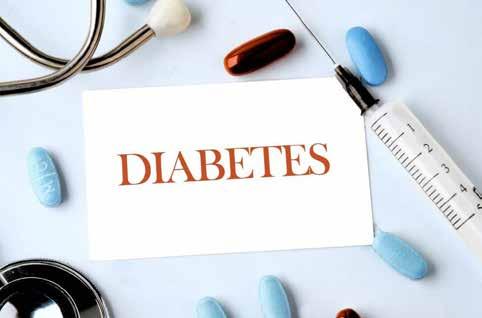




Washington, (EFE).- La candidata demócrata a la Casa Blanca, la vicepresidente Kamala Harris, y su rival republicano, el expresidente Donald Trump (20172021), han chocado con sus propuestas sobre inmigración, impuestos, aranceles, aborto y política exterior. Esto es lo que promete cada uno si llega al poder tras las elecciones del 5 de noviembre.
- Inmigración
Harris quiere hacer permanentes las restricciones al derecho de asilo que instauró

preMia edinbUrg a personalidades
La Cámara de Comercio hace ya los preparativos del 2024

Texas, el MoTor de eMpleos de eU
Lo da a conocer Greg Abbott, con base en datos de 12 meses
la Administración de Joe Biden ante las cifras récord de migrantes en la frontera y propone una reforma que ofrezca un “camino a la ciudadanía” para los indocumentados que viven en el país, sin dar detalles de cómo planea alcanzarla.
Trump estigmatiza a los migrantes con una retórica xenófoba y promete deportaciones masivas de indocumentados, retomar la construcción del muro y eliminar beneficios migratorios para personas que huyen de sus países, a pesar de los retos legales que supondrían estas medidas.

Composición de dos fotografías de archivo donde aparecen los dos candidatos presidenciales estadounidenses, la demócrata Kamala Harris y el republicano Donald Trump. EFE/W. Oliver/E.S. Lesser
- Aborto
Harris ha puesto la defensa del aborto como un tema central de su campaña y apuesta por una legislación que restaure los derechos reproductivos, si bien es poco probable que logre una mayoría en el Congreso suficiente para hacerlo.
Trump presume de que los jueces que colocó en el Tribunal Supremo tumbaron el derecho federal al aborto en 2022 y celebra que ahora cada estado es libre para restringir esa práctica, pero ha prometido que vetaría una prohibición nacional del aborto si la aprobara el Congreso.
- Política exterior
Harris llama a poner fin a la guerra de Gaza, al tiempo que promete seguir apoyando militarmente a Israel y apuesta por una solución de dos Estados. La demócrata mantendría el envío de armas a Ucrania y promete rivalizar con China de forma responsable.
Trump asegura que lograría terminar la guerra de Ucrania en 24 horas, aunque no ha explicado cómo. Ha criticado el envío de armas a Kiev, amenaza con salir de la OTAN, se ha posicionado como firme defensor de Israel y no apoya la creación de un Estado palestino.
La Coalición de Massachusetts para la Reforma Migratoria (MCIR) interpuso una demanda contra el Departamento de Seguridad Nacional (DHS) y el Servicio de Ciudadanía e Inmigración (USCIS) en el Tribunal de Distrito de Estados Unidos. El grupo alega que las políticas migratorias implementadas desde 2021 bajo la administración Biden ignoraron los requisitos de la Ley Nacional de Protección Ambiental (NEPA), la cual exige a las agencias federales evaluar el impacto ambiental de sus
decisiones.
Por el año 1970 fue creada la NEPA con el objetivo de asegurar que toda acción gubernamental que pueda afectar el medio ambiente pase primero por un análisis exhaustivo. La MCIR sostiene que las políticas de inmigración, como el fin de la construcción del muro fronterizo y la suspensión de la política de “Permanecer en México”, deberían haber sido revisadas bajo estos lineamientos, porque podrían tener consecuencias tanto para el medio
ambiente como para los recursos locales. Los demandantes, incluidos residentes de la frontera sur y otros estados, aseguran que la migración sin los análisis previos sobrecargó servicios en sus comunidades. Algunos residentes fronterizos incluso reportaron incendios accidentales en sus tierras debido al flujo migratorio, mientras habitantes de otros estados dicen que el crecimiento poblacional impactó en servicios como educación y salud.
(USPS Periodical Pending Permit #5)
Founded in 1986, published weekly by Online Media Group, Inc, committed to providing with quality news and information in Hidalgo, Starr, and Cameron counties, serving to the great Rio Grande Community.
Periodical postage paid McAllen, Texas, 78501
POSTMASTER SEND ADDRESS CHANGE
TO: El Periodico USA, 801 E. Fir Av., McAllen, Texas, 78501. The opinions expressed in the editorials of this publication represents the position and ideology of this newspaper; the opinions expressed by our writers and guest columnists are not necessarily the opinions of the management, staff or ownership of El Periódico U.S.A., the contents of which they are solely and exclusively responsible. Letters from our readers are welcome and will be published, subject to space availability as long as they are signed and have a proper return address. All letters will be reviewed and edited for offensive language, slander, and defamation and for proper grammar, spelling and accuracy, according to our style.
SERVICES: EFE, AMEX. AII, NotiPress, and Notistarz
El Periódico U.S.A., no es responsable por traducciones hechas por agencias de publicidad.
Ph. (956) 631-5628 Fax. (956) 631-0832. Division



Andrés Oppenheimer
no de los mayores misterios de la campaña para las elecciones del 5 de noviembre en Estados Unidos es por qué el candidato repub-
licano Donald Trump —que diariamente insulta a los indocumentados y ha dicho que los inmigrantes “están envenenando la sangre de nuestro país”— ha ido ganando terreno entre los votantes hispanos en los últimos años.
Para ser claros, Trump no lidera las encuestas entre los votantes hispanos, como lo afirma falsamente todo el tiempo. Una encuesta reciente de votantes hispanos del New York Times y Siena College muestra que Trump está recibiendo el 37% del voto latino a nivel nacional, contra un 56% de la vicepresidenta y candidata demócrata Kamala Harris.
Pero Trump ha aumentado su margen de apoyo entre los hispanos en alrededor de 9 puntos porcentuales desde las elecciones de 2016. Harris, por el otro lado, está obteniendo alrededor de 12 puntos porcentuales menos del voto latino del que recibió la candidata demócrata Hillary Clinton en 2016.
Los portavoces de la campaña de Harris dicen que muchos latinos que no siguen
regularmente las noticias no están al tanto de sus declaraciones que deshumanizan a los inmigrantes y promueven el odio racial. Y también dicen que muchos latinos no están tomando en cuenta el probable impacto del plan de deportaciones masivas de Trump, que según ellos podría implicar arrestos indiscriminados de latinos en las calles.
Trump ha venido escalando su discurso anti-inmigrante en días recientes, insistiendo en su falsa afirmación de que la mayoría de los indocumentados son criminales y que han “invadido” este país. De hecho, varios estudios han demostrado que los indocumentados cometen menos crímenes violentos que los estadounidenses. Y las cifras oficiales muestran que el número de cruces fronterizos no autorizados se ha desplomado en un 70 por ciento este año.
“Estas personas son animales”, dijo Trump en un mitin de campaña el 28 de septiembre, refiriéndose a los indocumentados. Sí, el candidato republicano había dicho el 16 de diciembre que los inmigrantes “están envenenando la sangre de nuestro país”, un término que popularizó el líder nazi Adolf Hitler.
Ernesto Castañeda, director del Centro de Estudios Latinoamericanos y Latinos de la American University, dice que una de las razones por las que muchos latinos apoyan a Trump es porque no creen que esté hablando de ellos cuando lanza sus diatribas contra los inmigrantes.

“Algunos dicen: ‘No está hablando de mí. Está hablando de otros, de los inmigrantes malos. Yo soy un inmigrante bueno”, me dijo Castañeda. Esa es peligroso, claro, porque una vez que se legitima el odio racial contra un grupo étnico, se normaliza el odio contra todas las minorías, y la discriminación racial, agregó.
Además, muchos latinos en distritos republicanos están tan ansiosos por integrarse a sus comunidades que adoptan las posturas pro-Trump de sus vecinos.
Algunos hispanos “creen que la mejor manera de ser aceptados como estadounidenses es votar por Trump. Piensan que eso aumentará su sentido de pertenencia”, me dijo Castañeda.
Los partidarios de Trump dicen que el aumento del apoyo latino al expresidente se debe a que a los hispanos les fue mejor bajo el gobierno de Trump, aunque las estadísticas económicas no respaldan esa afirmación.
Los hispanos están levemente mejor hoy que durante los años de Trump, según un estudio comparativo del Poynter Institute. La tasa de desempleo de los latinos se ha reducido a casi la mitad desde el principio del gobierno de Biden, según datos oficiales. Trump también afirma que los indocumentados les están quitando puestos de trabajo a los hispanos establecidos desde hace mucho tiempo. Sin embargo, según la Cámara de Comercio de Estados Unidos, hay una enorme escasez de trabajadores para cubrir los puestos que los estadounidenses y los residentes legales no quieren realizar.
Probablemente, la principal razón detrás del aumento del voto latino para Trump sea que el Partido Demócrata ha dado por sentado el voto latino.
Los demócratas saben que ganarán fácilmente en los principales estados con población hispana, como California y Nueva York, y que perderán Florida y Texas. Por eso no gastan muchos recursos tratando de cortejar a los votantes hispanos, aunque podrían ser un factor decisivo en estados indecisos como Nevada o Arizona.
Si las encuestas están en lo cierto y más latinos se inclinan por Trump, será un caso extraño de una minoría que apoya a un candidato que los insulta regularmente y aviva el odio racial, además de no haber hecho nada para mejorar su situación económica. Pero eso es lo que hacen los populistas carismáticos: son muy buenos para convencer a la gente de votar en contra de sus propios intereses.


Oferta por tiempo limitado.
Dos líneas a un bajo precio de Ahorra $5 en cualquier plan por los 3 primeros meses. 2
$ 24.98/mes.*
*Más $3.23 de cargo administrativo, cargos variables de USF/sobrecargos e impuestos por línea. Los precios requieren facturación electrónica.
líneas de servicio hasta 2/1/25. La facturación del plan regular comienza después de que la oferta termine. No todos los servicios están disponibles en todos los planes. Respuesta Urgente y Servicios de Operador disponibles 24/7 en inglés. Para las horas hábiles de Servicio al Cliente visite Lively.com/suppport/faqs. Respuesta Urgente rastrea la ubicación aproximada del teléfono al estar encendido y conectado a la red. Lively no garantiza la ubicación exacta. Lively no es un proveedor de atención médica. Calificado constantemente como rápido y confiable entre los mejores proveedores de servicios inalámbricos por Rootmetrics. Imágenes de pantalla simuladas. El dispositivo puede variar y no ser el de la imagen. Lively y Jitterbug son marcas registradas de Best Buy Health, Inc. ©2024 Best Buy. Todos los derechos reservados.



McAllen, Tx.- La estudiante de McAllen High School, Evelyn Garfield y Taylor Landez de Lamar Academy, en el Programa de Bachillerato Internacional de James “Nikki” Rowe High, fueron honradas el miércoles 16 de octubre mediante ceremonias de aceptación celebradas en sus respectivas instituciones, donde aceptaron oficialmente su lugar en la Universidad Texas A&M en Kingsville, convirtiéndose en unas de las 100 beneficiarias de una beca del centenario de TAMUK.
Directivos de la prestigiosa universidad, visitaron ambas instituciones para otorgarle a las alumnas beneficiadas su carta de aceptación en la clase de otoño 2025.
El éxito académico de Evelyn y Taylor refleja su incansable compromiso con la excelencia, estableciendo un alto estándar para sí mismas y sus compañeros.
McAllen ISD se enorgullece de celebrar los logros sobresalientes de ambas alumnas y anticipa ansiosamente el brillante futuro que les espera.
Taylor Landez de Lamar Academy, estudiante del Programa de Bachillerato Internacional de James “Nikki” Rowe High.

•
El día lunes 21 de octubre se inició la elección, entre otros, de congresistas federales, representantes estatales, numerosos comités directivos de distritos escolares y, la más importante, la de presidente o presidenta (Con A, como dice la mandataria mexicana Claudia Sheinbaum) de los Estados Unidos.
Quizá para otros países, especialmente los latinoamericanos, ese proceso resulte más que raro, ya que consiste en que previamente al día de la elección constitucional del cinco de noviembre en la Unión Americana se puede emitir el voto en una serie de lugares establecidos con ese fin y que permiten, en el estado de Texas, por poner un ejemplo, que los electores registrados puedan acudir cualquiera de los días entre el 21 de octubre y el primero de noviembre a expresar su voluntad electoral con toda tranquilidad, quedando reservado el final de la jornada para el segundo martes del mes de noviembre, como suele suceder en cada elección presidencial y de otros funcionarios estadounidenses. Así es que a partir de este lunes se puede ir llevando un comparativo de cómo van recibiendo respaldo los diferentes candidatos. En el estado de Texas están registrados casi 19 millones de electores. Dependiendo de cada estado de la Unión Americana puede haber variantes en la forma de emitir el voto y es común que se haga por correo en algunos lugares.
Pero el problema es que en el caso de las elecciones presidenciales la mayoría de los votos emitidos a favor de alguno de los candidatos no le da el triunfo, sino que es un colegio electoral el que decide. Así, estamos ante un proceso que, dado lo reñido de la contienda en la que Donald Trump, del Partido Republicano y Kamala Harris, del Partido Demócrata, han ido alternando las preferencias electorales por muy escaso margen, mantendrá en suspenso no solamente a los ciudadanos de los Estados Unidos, sino de muchos otros países que reciben los efectos de los cambios de gobierno estadounidense, uno de ellos, significativamente, México.
En México acaba de asumir la presidencia una mujer, como es sabido, y en razón de que hay un tratado de libre comercio y una enorme interacción en todos los órdenes entre ambas naciones, las repercusiones son más que importantes. Email: jose@bgarza.com
(Debate N).- - El Gobernador de Texas, Greg Abbott, felicitó a los trabajadores texanos y a los empleadores de Texas por liderar todos los estados en empleos creados durante los últimos 12 meses después de la publicación de datos sobre empleo por parte de la Oficina de Estadísticas Laborales de EE.UU (BLS, por sus siglas en inglés).
Texas agregó 327,400 empleos no agrícolas de septiembre de 2023 a septiembre de 2024, con mucho el mayor número en la nación, se reveló en un comunicado del Gobierno de Texas.
"Texas continúa dominando como el motor de empleos de la nación,” dijo el Abbott. "Las empresas de los Estados Unidos están huyendo del dominio de la reglamentación excesiva en otros estados por las ventajas competitivas que sólo se encuentran en Texas. Con el mejor clima de negocios en la nación y una fuerza laboral altamente calificada, diversa y en crecimiento, las empresas y los empresarios encuentran la libertad para innovar y crecer en Texas.
“Como resultado, más texanos están trabajando que nunca en la historia de nuestro estado, expandiendo las oportunidades económicas para más familias de Texas. Trabajando juntos, construiremos un Texas mejor y más grande para todos."
El anuncio de empleo de BLS sigue al anuncio del gobernador Abbott del viernes celebrando la fortaleza sin igual de la economía de Texas después de que la Comisión de Fuerza Laboral de Texas publicó los datos de septiembre de empleo mostrando que Texas creció empleos a un ritmo más rápido que los EE.UU. en su conjunto en los últimos 12 meses.


Edinburg, Tx.- El lunes arrancaron las nominaciones para los prestigiosos premios 2024 de la Cámara de Comercio de Edinburg, que honran a personas y organizaciones por sus contribuciones excepcionales a la comunidad de Edinburg.
Cada año, la Cámara de Comercio de Edinburg reconoce a quienes han tenido un impacto duradero a través de su dedicación, liderazgo y servicio. Las categorías de premios de este año incluyen Hombre y mujer del año, Pequeña empresa del año, Orgullo de Edinburg, Premio al mejor recién llegado, Excelencia en educación, Mejor evento comunitario y Premio al héroe local. “Esta es una oportunidad para honrar a

quienes se esfuerzan al máximo para servir a nuestra comunidad”, dijo Ronnie Larralde, director ejecutivo de la Cámara de Comercio de Edinburg. “Alentamos a todos a nominar a personas y organizaciones merecedoras que hayan marcado la diferencia”.
Los ganadores del premio serán homenajeados en el 92.º banquete anual de instalación y entrega de premios, que se llevará a cabo el 13 de noviembre de 2024.
Para obtener más información o descargar el formulario de nominación, visite www. edinburg.com/awards. Para consultas, comuníquese con la Cámara al 956-383-4974.


Notificación temprana y revisión pública de una propuesta actividad en una llanura aluvial designada por el Estándar Federal de Manejo de Riesgo de Inundación
Fecha de publicación: 30 de octubre de 2024
Este anuncio es para notificar que la Ciudad de McAllen, ha determinado que la siguiente acción propuesta bajo B-22-CP-TX-0870 está ubicada en la llanura aluvial del Estándar Federal de Manejo de Riesgo de Inundación (FFRMS, por sus siglas en inglés), y la Ciudad de McAllen, como Entidad Responsable, identificará y evaluará alternativas viables para ubicar la acción dentro de la zona de inundación y los posibles impactos en ella de la acción propuesta, según lo requerido por la Orden Ejecutiva 11988, enmendada por la Orden Ejecutiva 13690, de acuerdo con las regulaciones de HUD en 24 CFR 55.20 en la Subparte C Procedimientos para tomar determinaciones sobre el manejo de llanuras aluviales y la protección de humedales. La ubicación propuesta del proyecto es en el 2801 S. 10th St., McAllen, Texas 78501, Condado de Hidalgo. La extensión de la llanura aluvial FFRMS se determinó a través del Enfoque de Valor de Freeboard.
La propuesta es la adquisición de un terreno de 4.85 acres y la expansión del sitio de apoyo adicional a través de la nueva construcción de los Jardines de Aventura. La construcción propuesta de la expansión del Centro de Ecología Urbana (CUE) y la futura construcción de baños independientes y vestuarios se ubicarán en una llanura aluvial de 100 a 500 años (B) Riesgo Moderado 0.2% de probabilidad de evento de inundación anual. El objetivo estratégico es mejorar el espacio cívico existente de Quinta Mazatlán y expandir su presencia para mejorar la experiencia de los visitantes con el fin de convertirse en un destino de clase mundial en Texas. La expansión del Centro para la Ecología Urbana (CUE), tiene como objetivo empoderar a las comunidades, empresas e individuos para que tomen “acción” para lograr el crecimiento ambiental y económico para una región y un mundo más saludables; los Jardines Mágicos promoverán el crecimiento de un hábitat natural para la vida silvestre del sur de Texas y permitirán una oportunidad educativa para la comunidad.
Hay tres propósitos principales para este aviso. En primer lugar, las personas que puedan verse afectadas por las actividades en las áreas de inundación y las que tengan interés en la protección del medio ambiente natural deben tener la oportunidad de expresar sus preocupaciones y proporcionar información sobre estas zonas. Se alienta a los comentaristas a ofrecer sitios alternativos fuera del área de inundación, métodos alternativos para servir al mismo propósito del proyecto y métodos para minimizar y mitigar los impactos del proyecto en la [zona de inundación/humedal]. En segundo lugar, un programa adecuado de aviso público puede ser una herramienta educativa pública importante. La difusión de información y la solicitud de comentarios públicos sobre las áreas de inundación pueden facilitar y mejorar los esfuerzos federales para reducir los riesgos e impactos asociados con la ocupación y modificación de estas áreas especiales. En tercer lugar, como una cuestión de justicia, cuando el gobierno federal determina que participará en acciones que se lleven a cabo en una llanura aluvial, debe informar a aquellos que pueden estar en riesgo mayor o continuo.
Los comentarios por escrito deben ser recibidos por la Oficina de Administración de Subvenciones de la Ciudad de McAllen en la siguiente dirección en o antes del 7 de noviembre de 2024. La descripción completa de la acción propuesta puede revisarse en el Departamento de Administración de Subvenciones ubicado en el 1300 Houston Ave., 2do Piso, McAllen, Texas, durante las horas de 8:30 a.m. y 4:30 p.m. Los comentarios también se pueden enviar por correo electrónico a grant@mcallen.net. Los comentaristas deben especificar a qué parte de este aviso se refieren.
JULIA D. LASH, DIRECTORA DE ADMINISTRACIÓN DE SUBVENCIONES
CIUDAD DE MCALLEN P.O. BOX 220 McALLEN, TEXAS 78505-0220


Ganadora de los premios José Martí de la NAHP 2010, 2013, 2015, 2016, 2017, 2019, 2020 y 2021
DE
Investigadores crean sistemas basados en inteligencia artificial que detectan signos de depresión a través de smartphones, con un 76% de precisión
NotiPress.- A pesar de que aproximadamente 300 millones de personas en el mundo padecen depresión, detectarla no siempre es fácil. A menudo, los pacientes no logran comunicar su padecimiento a las personas más cercanas ni a los profesionales. Por tal motivo, un grupo de investigadores está desarrollando una tecnología para detectar de forma no invasiva los signos de la depresión. Esta herramienta se utiliza desde un smartphone impulsada por inteligencia artificial. El equipo de investigación de Pel et al. desarrolló un sistema llamado PupilSense que mide continuamente el tamaño de las pupilas de los usuarios de teléfonos inteligentes. La herramienta toma 10 segundos de fotografías continuas mientras el usuario abre la pantalla del smartphone, usa las redes sociales o aplicaciones. Al recopilar datos de 16,000 usos de teléfonos inteligentes de 25 voluntarios durante cuatro semanas, los investigadores construyeron un modelo de aprendizaje automático para distinguir entre respuestas normales y anormales. Los principales indicadores utilizados para predecir un episodio depresivo fueron las expresiones faciales, la frecuencia de la sonrisa, el estado de apertura y cierre de los ojos y los movimientos de la cabeza. La versión más eficiente del modelo pudo identificar cuándo las personas informaron ser conscientes de la depresión con un 76% de precisión. Este resultado logró superar el sistema de detección de depresión “Aware”, ya en funcionamiento.

Desarrollan tecnología de IA que detecta la depresión mediante smartphones con un 76% de precisión. Foto Sergio F Cara (NotiPress/Composición)
Una de las investigadoras que formó parte del proyecto, Bae Sang Won, tiene experiencia desarrollando un sistema que utiliza smartphones para detectar el consumo excesivo de alcohol y el consumo de marihuana. Estas investigaciones le permitieron demostrar plenamente la utilidad del concepto que utiliza las reacciones de los usuarios. Según Bae, muchos psicólogos señalaron que los movimientos de los músculos faciales y los gestos de la cabeza pueden ser indicadores no verbales de depresión. Por tal motivo, los investigadores también desarrollaron “FacePsy”, un sistema que analiza las expresiones faciales de los usuarios y lee su estado mental. Por cuestiones de privacidad, el equipo comentó que la aplicación elimina las imágenes tan pronto como se complete el análisis.
Algunas de las revelaciones a las cuales llegó el equipo es que los movimientos faciales disminuyeron en las horas de la mañana, y algunos movimientos de la cabeza y los ojos están fuertemente asociados con la depresión. Por ejemplo, un aumento en el acto de sacudir la cabeza de un lado a otro fue un signo notable de depresión. Además, abrir los ojos más por la mañana y por la noche puede estar relacionado con la depresión. Los investigadores descubrieron que los sentimientos depresivos a veces pueden ocultarse en cambios en las expresiones faciales y en movimientos que no pueden imaginarse a partir de la apariencia física. Mientras que las herramientas tradicionales de inteligencia artificial para detectar depresión suelen requerir de un dispositivo especializado, el equipo de Bae está entusiasmado por las tecnologías PupilSense y FacePsy, capaces de activarse simplemente usando un teléfono inteligente. Este sería el primer paso para crear una herramienta para que cualquier persona pueda diagnosticar fácilmente la depresión.
Adoptar hábitos saludables es clave para proteger el cerebro del deterioro cognitivo. Conoce cuatro cambios importantes que pueden hacer diferencia
NotiPress.- Como epicentro de las funciones vitales y emociones, el cerebro desempeña un papel esencial en cada aspecto de la vida. Sin embargo, a medida que se envejece o se atraviesan situaciones de estrés y malos hábitos, este órgano tan complejo puede verse afectado, comprometiendo la salud y bienestar. Además, el cerebro es el órgano más complejo del cuerpo humano, responsable de coordinar funciones vitales como el ritmo cardíaco, la capacidad de sentir y la memoria.
Dado que es el epicentro de las emociones y la existencia, mantener su salud es importante para una vida plena. Sin embargo, un alto porcentaje de la población sufre daños cerebrales debido a diversas causas, como la edad, los accidentes y la falta de cuidados adecuados. Según la Secretaría de Salud, más del 20% de los mexicanos mayores de 60 años presentan algún tipo de deterioro cognitivo.

Por su parte, los jóvenes también empiezan a experimentar envejecimiento cerebral prematuro, influenciado por el estrés y la pandemia, según un estudio de la Universidad de Stanford. Ante esta situación, es
fundamental adoptar cambios en el estilo de vida para promover la salud cerebral. En primer lugar, el consumo de precursores de glutatión, como los presentes en suplementos alimenticios, es una estrategia

clave. El glutatión es un antioxidante que protege las células cerebrales del daño oxidativo y reduce la inflamación y, según recientes investigaciones, su consumo puede prevenir lesiones cerebrales microscópicas y mejorar la función cognitiva, reduciendo el riesgo de enfermedades neurodegenerativas como el Alzheimer y el Parkinson. Asimismo, en segundo lugar, prestar atención de manera consciente a la experiencia del momento (mindfulness) es una técnica que fomenta la atención plena y resulta muy beneficioso. Esta práctica ayuda a disminuir el estrés e incrementa la materia gris en áreas cerebrales vinculadas a la memoria y la toma de decisiones. Incorporar mindfulness en la rutina diaria puede contribuir significativamente a la salud cerebral.
La tercera recomendación es seguir la dieta MIND, diseñada para proteger el cerebro y reducir el riesgo de demencia. Esta dieta combina elementos de la dieta mediterránea y, el enfoque DASH, promueve el consumo de alimentos ricos en antioxidantes, como frutas y verduras de hoja verde, mientras se limita la ingesta de carnes rojas y productos procesados.
Finalmente, estimular la mente mediante actividades como leer, aprender un nuevo idioma o tocar un instrumento musical es fundamental para mantener la agilidad cognitiva. Estas actividades mejoran la memoria y el estado de ánimo y contribuyen a un envejecimiento saludable y a la prevención de enfermedades neurodegenerativas.
NotiPress.- Los factores ambientales y los hábitos de vida juegan un papel crucial en el desarrollo y progresión de las enfermedades autoinmunes, según Cristina Valencia Sánchez, neuróloga de la Mayo Clinic en Arizona. Durante una entrevista exclusiva con NotiPress, explicó cómo elementos como la alimentación, el ejercicio físico y la exposición a ciertos factores ambientales pueden influir significativamente en el curso de patologías como la esclerosis múltiple y el MOGAD.

Por su parte, la especialista señaló la importancia de llevar una vida saludable como una medida preventiva. “Sabemos que una dieta equilibrada, como la mediterránea, y la actividad física regular pueden mejorar la calidad de vida de los pacientes con esclerosis múltiple”, afirmó. Además, mencionó que la deficiencia de vitamina D se ha relacionado con un peor pronóstico en estos pacientes. “Recomiendo a mis pacientes que mantengan niveles adecuados de vitamina D, ya que puede tener beneficios

potenciales en la evolución de la enfermedad”, añadió. La neuróloga también señaló que las condiciones ambientales, como la exposición a contaminantes y la infección por ciertos virus, pueden desencadenar o agravar estas enfermedades. “Factores como el tabaco o la exposición a infecciones virales, como el virus de Epstein-Barr, están claramente aso-
ciados con un mayor riesgo de desarrollar esclerosis múltiple”, explicó. La entrevista se dio en el contexto del 8º simposio de neurociencias en Ciudad de México el 4 de octubre de 2024, organizado por Médica Sur.
Lunes a Viernes 9:00am - 6:00pm S ábado de 9:00 am-12:30 pm

En cuanto a los hábitos de vida, Valencia Sánchez enfatizó que el ejercicio físico, adaptado a cada paciente, es esencial no sólo para mejorar síntomas como la fatiga, sino también para mantener una mejor salud general. “El ejercicio debe adaptarse a las condiciones de cada paciente, pero sin duda es fundamental para su bienestar”, explicó.
Así, el impacto de los factores ambientales y los hábitos de vida en las enfermedades autoinmunes, como la esclerosis múltiple y el MOGAD, es innegable. Mantener una dieta equilibrada, realizar ejercicio físico adecuado y controlar la exposición a ciertos factores puede mejorar la calidad de vida de los pacientes. A medida que se avanza en la investigación, la comprensión de cómo los hábitos de vida afectan estas enfermedades sigue siendo clave para el manejo integral de los pacientes.
Una dieta saludable, ejercicio y factores ambientales influyen en la evolución de enfermedades autoinmunes.

El Dr. Zaragoza, asesor médico para Lilly en México, habló sobre qué tan cerca se encuentra la medicina para encontrar una cura para el Alzheimer
NotiPress.- La enfermedad de Alzheimer es un trastorno cerebral que destruye lentamente la memoria y la capacidad de pensar. El paciente experimenta cambios en su conducta y su personalidad y, con el tiempo, pierde la capacidad de realizar acciones cotidianas. Esta enfermedad es más común de lo que se cree. Según la Organización Mundial de Salud, hay aproximadamente 60 millones de personas a nivel mundial con Alzheimer. Es por eso que la comunidad médica hace todo lo posible para enfrentarse a esta enfermedad. Pero, mientras tanto, cabe preguntarse qué tan cerca se encuentran de encontrar una cura.
Para encontrar una respuesta, NotiPress mantuvo una entrevista con el doctor José Luis Zaragoza, asesor médico para Lilly en México. El doctor explicó que actualmente la compañía está trabajando en el desar-

Un especialista responde qué tan cerca se encuentra la comunidad médica de encontrar una cura para el Alzheimer.
rollo de alternativas de tratamiento que impacten en el bienestar y calidad de vida de los pacientes y sus familias.
El trabajo de Lilly no solamente se enfoca en el componente farmacológico, sino que también se orienta a la búsqueda de diferentes estrategias para facilitar el entendimiento de la enfermedad, el diagnóstico oportuno y la educación médica continua. Además, se busca mejorar la navegación de los retos que tiene esta condición para otor-
Ciudadanías Visas de negocio/trabajo
Perdones Provisionales Residencias
Háblanos para ver si calificas para el Programa Nuevo del Presidente Biden para Mantener a las familias unidas
Perdones
Deportaciones
gar la mejor calidad de vida posible. Los pacientes con la enfermedad de Alzheimer sienten que “cualquier mejora que el tratamiento pueda brindar en cómo se sienten o en su capacidad para participar en las tareas diarias puede proporcionar la esperanza y el ánimo necesarios”, asegura el Dr. Zaragoza. No obstante, el profesional señala que actualmente los sistemas de salud están diseñados para tratar los síntomas de la enfermedad cuando éstos se hacen im-
posibles de ignorar. Al consultarle sobre si la medicina moderna está cerca de encontrar una cura, Zaragoza afirmó que los últimos años han sido un periodo agridulce, entre momentos esperanzadores y muy frustrantes. En este sentido, aseguró que hoy no existe un tratamiento que ofrezca una “curación” de la enfermedad. Sin embargo, se tiene la posibilidad de que surjan nuevas opciones de tratamiento para otorgar una mejor calidad de vida a los pacientes y disminuir la progresión del Alzheimer. Aun así, el doctor sostiene que a la ciencia le falta un largo recorrido para llegar a una opción curativa de la enfermedad.
Mientras tanto, desde Lilly aseguran estar avanzando en la ciencia de la enfermedad de Alzheimer. Por ende, se compromete a colaborar con la comunidad del Alzheimer para descubrir y ofrecer soluciones diagnósticas y terapéuticas innovadoras. De esta forma, se podrá desarrollar un mejor futuro para las personas que viven con esta enfermedad.
Durante los últimos 30 años que Lilly ha dedicado a la investigación de la enfermedad de Alzheimer, se han hecho descubrimientos reveladores como las placas de amiloide o las alteraciones de la proteína tau, las cuales pueden aparecer en el cerebro décadas antes de que la persona muestre síntomas. A partir de estas revelaciones se ha podido desarrollar diagnósticos y terapias avanzadas para mejorar la calidad de vida del paciente.

NotiPress.- En los años más recientes, el uso de remedios herbales ganó popularidad como alternativa a tratamientos convencionales. Sin embargo, esta tendencia plantea serias preocupaciones de salud debido a la falta de regulación en el mercado de suplementos botánicos. Una investigación de la Universidad de Michigan puso en manifiesto esta problemática, especialmente en Estados Unidos. Allí, se estimó que 15 millones 600 mil personas utilizan al menos un tipo de tratamiento herbáceo con potencial para dañar el hígado. Los investigadores encuestaron a 9 mil 685 personas inscritas en la Encuesta Nacional de Examen de Salud y Nutrición de Estados Unidos. El objetivo fue evaluar la prevalencia y las características clínicas de quienes consumen productos botánicos considerados potencialmente hepatotóxicos. Asimismo, se analizaron los datos relacionados con el uso de medicamentos y suplementos dietéticos herbales (HDS, por sus siglas en

inglés) para comprender las razones detrás del consumo y los factores del aumento en el riesgo de daño hepático.
El equipo de investigación, liderado por Alisa Likhitsup, hematóloga de la Universidad de Michigan, descubrió el uso de remedios herbales es más frecuente entre personas con enfermedades crónicas como diabetes y artritis. También, los consumidores habituales de este tipo de medicamentos suelen tener entre 40 y 60 años. Por otro lado, los remedios analizados en el estudio se empleaban comúnmente para tratar afecciones como el colesterol alto, la depresión y el dolor. En ese sentido, la encuesta reveló que el 57.6% de los participantes utiliza HDS, con productos que incluyen cúrcuma, extracto de té verde, ginseng indio, tamarindo malabar (garcinia cambogia), arroz de levadura roja y cohosh negro.
La cúrcuma, en particular, es utilizada frecuentemente para aliviar molestias articulares, debido a su supuesta capacidad antioxidante y antiinflamatoria. Los ensayos clínicos previos no logró demostrar la eficacia de los productos que contienen cúrcuma para tratar la osteoartritis. Sin embargo, la falta de regulación en la industria de los remedios herbales es un gran problema. Por otra parte, el estudio indicó que las lesiones hepáticas provocadas por el consumo excesivo de dichos productos son difíciles de diagnosticar en etapas tempranas.














Type 1 diabetes, once known as juvenile diabetes or insulin-dependent diabetes, is a chronic condition. In this condition, the pancreas makes little or no insulin. Insulin is a hormone the body uses to allow sugar (glucose) to enter cells to produce energy.
Different factors, such as genetics and some viruses, may cause type 1 diabetes. Although type 1 diabetes usually appears during childhood or adolescence, it can develop in adults.
Even after a lot of research, type 1 diabetes has no cure. Treatment is directed toward managing the amount of sugar in the blood using insulin, diet and lifestyle to prevent complications.
Type 1 diabetes symptoms can appear suddenly and may include:
• Feeling more thirsty than usual
• Urinating a lot
• Bed-wetting in children who have never wet the bed during the night
• Feeling very hungry
• Losing weight without trying
• Feeling irritable or having other mood changes
• Feeling tired and weak
• Having blurry vision
When to see a doctor
Talk to your health care provider if you
notice any of the above symptoms in you or your child.
Causes
The exact cause of type 1 diabetes is unknown. Usually, the body’s own immune system — which normally fights harmful bacteria and viruses — destroys the insulin-producing (islet) cells in the pancreas.
Other possible causes include:
• Genetics
• Exposure to viruses and other environmental factors
The role of insulin
Once a large number of islet cells are destroyed, the body will produce little or no insulin. Insulin is a hormone that comes from a gland behind and below the stomach (pancreas).
• The pancreas puts insulin into the bloodstream.
• Insulin travels through the body, allowing sugar to enter the cells.
• Insulin lowers the amount of sugar in the bloodstream.
• As the blood sugar level drops, the pancreas puts less insulin into the bloodstream.
The role of glucose
Glucose — a sugar — is a main source
of energy for the cells that make up muscles and other tissues.
• Glucose comes from two major sources: food and the liver.
• Sugar is absorbed into the bloodstream, where it enters cells with the help of insulin.
• The liver stores glucose in the form of glycogen.
• When glucose levels are low, such as when you haven’t eaten in a while, the liver breaks down the stored glycogen into glucose. This keeps glucose levels within a typical range.
In type 1 diabetes, there’s no insulin to let glucose into the cells. Because of this, sugar builds up in the bloodstream. This can cause life-threatening complications.
Risk factors
Some factors that can raise your risk for type 1 diabetes include:
• Family history. Anyone with a parent or sibling with type 1 diabetes has a slightly higher risk of developing the condition.
• Genetics. Having certain genes increases the risk of developing type 1 diabetes.
• Geography. The number of people who have type 1 diabetes tends to be higher as you travel away from the equator.
• Age. Type 1 diabetes can appear at any age, but it appears at two noticeable peaks. The first peak occurs in children between 4 and 7 years old. The second is in children between 10 and 14 years old.
Complications
Over time, type 1 diabetes complications can affect major organs in the body. These organs include the heart, blood vessels, nerves, eyes and kidneys. Having a normal blood sugar level can lower the risk of many complications. Diabetes complications can lead to disabilities or even threaten your life.
• Heart and blood vessel disease. Diabetes increases the risk of some problems with the heart and blood vessels. These include coronary artery disease with chest pain (angina), heart attack, stroke, narrowing of the arteries (atherosclerosis) and high blood pressure.
• Nerve damage (neuropathy). Too much sugar in the blood can injure the walls of the tiny blood vessels (capillaries) that feed the nerves. This is especially
true in the legs. This can cause tingling, numbness, burning or pain. This usually begins at the tips of the toes or fingers and spreads upward. Poorly controlled blood sugar could cause you to lose all sense of feeling in the affected limbs over time.
Damage to the nerves that affect the digestive system can cause problems with nausea, vomiting, diarrhea or constipation. For men, erectile dysfunction may be an issue.
• Kidney damage (nephropathy). The kidneys have millions of tiny blood vessels that keep waste from entering the blood. Diabetes can damage this system. Severe damage can lead to kidney failure or end-stage kidney disease that can’t be reversed. End-stage kidney disease needs to be treated with mechanical filtering of the kidneys (dialysis) or a kidney transplant.
• Eye damage. Diabetes can damage the blood vessels in the retina (part of the eye that senses light) (diabetic retinopathy). This could cause blindness. Diabetes also increases the risk of other serious vision conditions, such as cataracts and glaucoma.
• Foot damage. Nerve damage in the feet or poor blood flow to the feet increases the risk of some foot complications. Left untreated, cuts and blisters can become serious infections. These infections may need to be treated with toe, foot or leg removal (amputation).
• Skin and mouth conditions. Diabetes may leave you more prone to infections of the skin and mouth. These include bacterial and fungal infections. Gum disease and dry mouth also are more likely.
• Pregnancy complications. High blood sugar levels can be dangerous for both the parent and the baby. The risk of miscarriage, stillbirth and birth defects increases when diabetes isn’t well-controlled. For the parent, diabetes increases the risk of diabetic ketoacidosis, diabetic eye problems (retinopathy), pregnancy-induced high blood pressure and preeclampsia.
There’s no known way to prevent type 1 diabetes. But researchers are working on preventing the disease or further damage of the islet cells in people who are newly diagnosed.
Ask your provider if you might be eligible for one of these clinical trials. It is important to carefully weigh the risks and benefits of any treatment available in a trial.

The University of Texas Rio Grande Valley (UTRGV) baseball team will host a draft party for fans on Nov. 8 at 6 p.m. at Howling Rabbit before playing the Orange and Gray World Series Nov. 13-15 at UTRGV Baseball Stadium.
Fans at the draft party will have the opportunity to watch team captains choose their teams ahead of the world series. Howling Rabbit is located at 1200 Auburn Ave. in McAllen.
The first two games of the world series are set for Nov. 13 and Nov. 14 at 3 p.m. with the finale, which will be played regardless of the outcome of the first two games, on Nov. 15 at 6:30 p.m.
The Orange and Gray World Series caps the fall competition season for the Vaqueros, a time which has featured practices and intrasquad games. The Vaqueros return to the field for practice in January ahead of the season opener in mid-February.



Date & Time:
Thursday, October 31, 2024
7:00 PM – 9:00 PM
Location:
Bentsen-Rio Grande Valley State Park
Event Contact:
T.C. Riddle
Phone: (956) 584-9156, x234
Email: thomas.riddle@tpwd.texas.gov
Event Overview:
Join us for a thrilling night ride through the park! As darkness falls, explore the nocturnal world with our guided shuttle ride. You’ll have the chance to spot night creatures like snakes, spiders, scorpions, owls, and more. Keep your ears open for the haunting calls of coyotes, owls, and pauraques. It’s a spooky, educational adventure for all ages!
What to Bring:
Water
Flashlight (red light preferred)
Where to Meet: Park Headquarters, Tram Turnaround
Registration: Reservations are required. Registration opens on October 1st.
Cost:
$5 for ages 13 & older FREE for children 12 & under Park entry is free with a Texas State Park Pass
Accessibility: For more information on service animals and wheelchair accessibility, please contact the park.
Note:
Events may be canceled due to weather. Please contact the park for updates.

The Rio Grande Valley Vipers, the NBA G League Affiliate of the Houston Rockets, announced the schedule for the Vipers 2024-25 season. The schedule features a total of 50 games, including 24 home games at Bert Ogden Arena, 24 games on the road and two games at the 2024 NBA G League Winter Showcase in Florida.
On Nov. 9 the Vipers tip-off the 2024-25 season with a matchup, at home, against the Memphis Hustle. This game will mark the start of the 16-game Tip-Off Tournament, which will culminate in a single-elimination tournament at the 2024 NBA G League Winter Showcase. Following the conclusion of showcase, the 34-game regular season will begin on Dec. 27 as the Vipers welcome the Santa Cruz Warriors to the Rio Grande Valley for a back-to-back series.
To begin the season in November, the Vipers will go on a four-game stretch against the Hustle (9th), Austin Spurs (12th) and back-to-back games against the Birmingham Squadron (14th and 15th). The Vipers will then go on the road to play three games against the Oklahoma City Blue (22nd) and Mexico City Capitanes (24th and 26th) before returning to the RGV on Nov. 30.
A Texas showdown will take place in December as the Vipers travel to Frisco to take on the Texas Legends in a back-to-back contest on the 6th and 7th. The Texas action continues on the 10th as the Spurs return to the Valley for the Vipers annual Kids’ Day game.
In January the Vipers will take on the Salt Lake City Stars (1st and 3rd), Oklahoma City Blue (7th and 9th), Iowa Wolves (11th), Spurs (17th and 20th), Mexico City (25th) and Sioux Falls (31st).
After four years of not playing one another, the Vipers will welcome the Cleveland Charge to the RGV for a twogame series on February 1st and 3rd. The battle of the Valley’s will happen on Feb. 13th as the Vipers travel to Arizona for a game against the Valley Suns. The Valley Suns enter the G League as the newest team in the Western Conference. The affiliate team of the Phoenix Suns will be based out of Tempe, Arizona and will play its home games at Mullett Arena. The Vipers will then go on the road to take on College Park on Feb. 28th and March 2nd. The last game between both opponents was in 2020.
The Vipers schedule will close in March with a total of 13 games (six road games and seven home games). The Vipers will close out the season with a back-to-back against the Stockton Kings on the 28th and 29th at home.
All home games will tip-off at 7:00 p.m. CST at the Bert Ogden Arena with the exception of the Kid’s Day game on Dec. 10 which is slated for an 11:00 a.m. CST tip-off time.
Senior
Juan Luis de Bethencourt
Duque held on to his first day individual lead to be crowned champion at the Monterrey Collegiate Classic leading The University of Texas Rio Grande Valley (UTRGV) Vaqueros men’s golf team on Saturday at Club Campestre.
Duque finished his second round with a six-under 66 before posting a final round one-under par to finish with a three-round score of 203 for a one-shot victory. Duque’s 203 breaks Armen Kirakossian’s (2009) and Manuel Inman’s (1999) program record of 204. His first and second round six-under 66 are tied for sixth lowest individual round in program history.
Junior Luis Limón, who was playing as an individual, finished tied for 22nd with a three-round score of 214 after posting his second round of even par 72 and then following with a two-under 70. Junior Arthit Kruaprayong finished tied for 25th with a three-round score of 215 after finishing the second round with a two-under 70 and posting a final round 73.
Sophomore McAllen Memorial alum Esteban Gonzalez finished tied for 25th with a three-round score of 215 after finishing the second round with a two-under 70 and following with another 70 in the final round.
Redshirt senior Taj Sutherland finished tied for 56th with a three-round score of 225 after finishing with an even par 72 and wrapping up with a final round 75. Sophomore Emilio Gil Leyva finished tied for 66th with a three-round score of 229 after finishing with a second round 79 and then posting a final round 76.
As team, the Vaqueros finished in fifth place with a three-round score of 854 after finishing with a second round 278, which is tied for the eighth lowest single round team score in program history, before following with a final round 289.
The Vaqueros have wrapped up their fall season and will be back in action in the spring. Their schedule will be announced at a later date.
Results
Golfer
Juan Luis de Bethencourt Duque
Luis Limón
Arthit Kruaprayong
Esteban Gonzalez
Taj Sutherland
Emilio Gil Leyva
Team
North Dakota State
Loyola marymount
Utah State
Richmond
UTRGV
Valparaiso
Seattle U VCU
Davidson
Creighton
Tarleton State
George Washinigton

Knapp Medical Center in Weslaco, a member of the Prime Healthcare Foundation, has been recognized for 5-star care of heart attack, diabetes, hip fracture, and gall bladder patients.
The recognition from Healthgrades — a national company which specializes in research and information about healthcare — is the latest accolade for Knapp, which serves as the only acute care hospital in the Mid-Valley area, with 227 beds.
Knapp Medical Center’s recognition includes the following:
• 5-Star Recipient for Hip Fracture Treatment for 13 Years in a Row (2013-2025)
• 5-Star Recipient for Gallbladder Removal Surgery for 11 Years in a Row (20152025)
• 5-Star Recipient for Treatment of Diabetic Emergencies for 3 Years in a Row (2023-2025)
• 5-Star Recipient for Treatment of Heart Attack for 2 Years in a Row (2024-2025)
The five-star ratings reflect Knapp Medical Center’s commitment to consistently deliver the best care possible and place the organization in the upper echelon of hospitals for specialty care nationwide, according to Healthgrades.
Rene Lopez, Chief Executive Officer at Knapp Medical Center, said Knapp’s 5-star ratings are a testament to the work of employees and physicians — who are dedicated to providing the highest-quality healthcare to residents of the Valley, every patient, every time.
“The 5-star ratings indicate the level of commitment our employees have in ensuring our patients receive the best healthcare experience possible,” Mr. Lopez said. “By treating each one of our patients with personalized attention and specialized care, our clinical and non-clinical staff prove each and every day that we are here to care for our community and that we are prepared to meet their healthcare needs.”
Anna Hinojosa, Chief Nursing Officer for Knapp Medical Center, said Knapp’s multiple 5-star ratings are demonstrable proof that
patients at the Weslaco hospital are receiving excellent care — and is an important tool for Rio Grande Valley residents to recognize when they weigh their healthcare options.
Knapp Medical Center’s achievements are based solely on what matters most: patient outcomes. As part of its 2025 hospital assessment, Healthgrades evaluated risk-adjusted mortality and complication rates for over 30 of the most common conditions and procedures at approximately 4,500 hospitals nationwide to determine the top performers in specialty care. By offering easy access to objective performance measures, Healthgrades helps consumers find and select a hospital that excels in providing the care they need
As variation in performance among hospitals continues to grow, it is increasingly important for consumers to seek care at top-rated programs. Healthgrades’ 2025 analysis revealed that if all hospitals as a group performed similarly to five-star hospitals during the 2021-2023 study period, on average, 224,958 lives could potentially have been saved and 141,692 complications could potentially have been avoided.*
“Healthgrades commends Knapp Medical Center for their clear commitment to delivering consistently superior patient outcomes in critical service areas, including hip fracture treatment, gallbladder removal surgery, treatment of diabetic emergencies, and treatment of heart attack,” said Brad Bowman, MD, chief medical officer and head of data science at Healthgrades. “Knapp Medical Center’s leadership, expertise, and unwavering dedication to clinical excellence set a high mark for specialty care in Texas and nationwide.”
In addition to the 5-star recognition from Healthgrades, Knapp Medical Center was one of only three hospitals in the Rio Grande Valley to receive an “A” grade for patient safety from the Leapfrog Group, a national healthcare ratings organization. The other two hospitals receiving this highest possible grade were Knapp’s sister hospitals in Prime Healthcare, Mission Regional Medical Center and Harlingen Medical Center.
Consumers can visit www.healthgrades. com to learn more about how Healthgrades measures hospital quality. Consumers can also access a patient-friendly overview of how Healthgrades rates hospitals and why hospital quality matters here.

For more information on award-winning hospital care in the Valley, please contact Knapp Medical Center at (956) 968-8567 or visit www.KnappMed.org and www. FaceBook.com/KnappMedicalCenter/.
*Statistics are based on Healthgrades analysis of MedPAR data for years 2021 through 2023 and represent three-year estimates for Medicare patients only. Click here to view the complete 2025 Specialty Awards and Ratings Methodology.

Withthe arrival of fall, local health authorities are reminding residents that it’s time to get their flu and COVID-19 vaccines. Health officials emphasize that you can receive both vaccines together, and each is updated yearly to provide protection against the latest strains.
Dr. Chris Romero, Health Authority for the City of Brownsville, noted that flu season traditionally runs from fall through spring but can extend into the summer in the Rio Grande Valley. “The best way to protect yourself and your family is to get vaccinated,” said Romero. “Getting vaccinated is the best thing we can do to prevent infection and minimize the risk of developing severe diseases.”
According to the Centers for Disease Control and Prevention (CDC), everyone six months and older should receive the flu vaccine annually. Romero stressed that the young and elderly are particularly vulnerable due to changes in their immune systems over time. “People at the extremes of the age range, both very young and older individuals, have immune system changes that can
put them at risk for severe disease,” Romero explained. “Those with underlying health issues are also at greater risk.”
Residents are also encouraged to get the latest COVID-19 vaccine, which has been tailored to combat the most prevalent variant currently circulating in the community. “The COVID-19 vaccines that are on the market right now are covering the variant that’s most common in our area,” said Romero. “While vaccines may not prevent every infection, they can significantly reduce the severity of illness.”
Romero likened the effectiveness of vaccines to armor against disease. “The amount of protection we have from vaccinations to reduce the severity of infections—whether it’s from the COVID-19 virus or the influenza virus—is something we constantly research. But we know that both vaccines are effective in reducing the severity of illness, even if someone does come down with it,” he said.
Local health experts urge Brownsville residents to ensure their vaccinations are up to date for optimal protection this fall.


BY ANDRES OPPENHEIMER

One of the biggest mysteries of the Nov. 5 elections is why Republican candidate Donald Trump — who insults undocumented migrants on a daily basis and has claimed that immigrants are “poisoning the blood of our country” — has been gaining ground among Hispanic voters.
To be sure, Trump is far from leading in the polls among Hispanic voters, as he falsely claims all the time. But Trump has been gradually eroding the Democrats’ once massive support among Latinos nationwide, and expanding his lead in major sub-groups such as Cuban-Americans in South Florida.
A recent New York Times-Siena poll of Hispanic voters shows Trump is getting 37% of the Latino vote nationwide, while vice-president and Democratic candidate Kamala Harris is winning 56% of the vote. A separate Pew Research Center poll shows a similar result, with Harris winning the
Hispanic vote by 57% to 39%.
But Trump has increased his margin of Latino support by about 9 percentage points since the 2016 elections, while Harris is getting about 12 percentage points fewer than what former Democratic candidate Hillary Clinton got that year, polls show.
Harris campaign spokespeople say that perhaps they haven’t been fully successful in making sure that Latinos who don’t regularly follow the news are aware of Trump’s own statements dehumanizing immigrants and spouting racial hatred. And there should be much more awareness about Trump’s vow to carry out the largest mass deportation in U.S. history, which could entail indiscriminate arrests of Latinos on the streets, they say.
“We should be doing a much better job reminding the Hispanic community about this man’s conduct when he was president, his hate-mongering rhetoric, his claims that immigrants are the cause of this country’s problems, and his plan to carry out mass deportations,” Harris campaign spokeswoman Julissa Reynoso, a former U.S. ambassador to Spain, told me.
In the campaign’s closing days, the central theme of Trump’s campaign is his false claim that most undocumented immigrants are criminals, and that they have “invaded” this country. In fact, several studies have shown that unauthorized migrants on average commit fewer violent crimes than U.S.-born Americans, and U.S. Customs and Border Patrol figures show that the number of unauthorized border crossings has plummeted by 70% this year.
“These people are animals,” Trump said at a Sept. 28 campaign rally. He claimed that “They make our criminals look like babies.”
Lashing out against immigrants for what he claimed are high crime rates, Trump said in an Oct. 7 interview with a right-wing radio host that “it’s in their genes...and we got a lot of bad genes in our country right now.”
Trump has been ramping up his anti-immigrant rhetoric since his 2016 campaign, when he famously claimed that Mexican immigrants “are bringing drugs, they’re bringing crime, they’re rapists, and some, I assume, are good people.”
Despite the fact that his claims about undocumented immigrants have been proven wrong, Trump has turned his anti-immigration crusade into his top campaign issue. He recently falsely claimed that Haitian immigrants are eating the dogs and cats of residents of Springfield, Ohio, despite the fact that Springfield police authorities, the city’s Republican mayor and Ohio’s Republican governor denied the former president’s assertion.
Ernesto Castañeda, head of the Center for Latin American and Latino Studies at American University, says that one of the reasons why so many Latinos support Trump is that they do not believe he is talking about them when he launches his tirades against immigrants.
“Some of them say, ‘He’s not talking about me. He’s talking about others, the bad immigrants. I’m a good immigrant,’” Castañeda told me. That’s a tricky proposition, he added, because once you legitimize
racial hatred against one ethnic group, you normalize hate against Jews, Muslims and all minorities.
In addition, many Latinos living in Republican districts are so eager to blend into their communities that they adopt their neighbors’ pro-Trump stands. Some Hispanics “believe that the best way to be accepted as Americans is to vote for Trump. They think that will increase their sense of belonging,” Castañeda told me.
Trump supporters say the rise in Latino support for the former president is because Hispanics fared better under Trump, although economic statistics don’t support that claim .
Hispanics are better off today than during the Trump years, most economic data show. The unemployment rate for Latinos has nearly fallen by half during Biden’s term, although that’s in part because the economy has recovered since the pandemic. Despite higher inflation in the first two years of the Biden administration, Latinos’ inflation-adjusted wages are higher today than during Trump’s years in office, a Poynter Institute study based on official data shows.
Trump has also tried to make the case that Latino immigrants are taking away jobs from long established Hispanics, but that’s another false claim. According to the U.S. Chamber of Commerce, there is a huge shortage of workers to fill jobs that Americans don’t want to do.
My own guess is that Trump’s rise among Hispanic voters — which is mainly taking place among men, according to the polls — may have something to do with some Latinos’ subconscious attraction to authoritarian leaders. Many may have a soft spot for “hombres fuertes,” or strong men, even if such leaders have often destroyed the countries they came from.
But perhaps the main reason for Trump’s gains among Hispanics is that the Democratic Party has taken the Latino vote for granted. Democrats know they will easily win major Hispanic population states such as California and New York, and that they will lose Florida and Texas. So they don’t spend much resources trying to court Hispanic voters, even if they could be a deciding factor in swing states such as Nevada or Arizona.
Unlike former President Barack Obama, who used to air campaign ads speaking in what sounded like fluent Spanish — even though he didn’t speak the language — you don’t see Harris or any of her potential Cabinet members do that today. And Trump has done a much better job than Harris wooing Cuban-American voters, for instance, who care deeply about their native country.
If the polls are right and more Latinos drift toward Trump, it will be a weird case of a growing minority of Hispanic voters embracing a candidate who regularly insults them and stokes racial hatred against them. Moreover, Trump has not done a thing to improve their economic situation. But that’s what charismatic populists do: they are great at convincing people to vote against their own interests.

Brownsville South Padre Island International Airport (BRO) has been named a finalist for the prestigious Accessible Airports Award at the International Airport Review’s Airport Honour Awards. This recognition celebrates BRO’s outstanding achievements in excellence, innovation, and commitment to responsible development.
The Accessible Airport Award celebrates airports committed to creating a welcoming and inclusive environment for all passengers, no matter their needs.
As a non-hub airport, BRO’s inclusion as a finalist stands out, especially as it competes against major international airports such as Dubai Airport, London Stansted, Dallas Love Field, and Aeropuertos Argentina. This achievement underscores BRO’s growing reputation within the aviation industry and showcases the airport’s dedication to accessibility and customer service.
The award winners will be announced on November 13, 2024, during the International Airport Summit, marking a significant moment for BRO as it takes the global spotlight alongside the world’s leading airports.
“The commitment ing




As the 2024 U.S. presidential election heats up, the nation finds itself at a crossroads with two candidates presenting distinct visions for the future: Vice President Kamala Harris, representing the Democratic Party, and former President Donald Trump for the Republican Party. Both candidates bring to the table competing strategies for tackling critical issues such as the economy, foreign policy, social justice, and climate change. The outcome of this race will not only shape U.S. policies but will also have significant implications on the country’s unity, role on the global stage, and domestic progress.
Economic Visions: Two Paths to Prosperity
Economic policy is central to both campaigns, especially given the inflationary pressures and economic recovery needs following the pandemic. Harris proposes an agenda aimed at strengthening the middle class through investment in education, healthcare, and clean energy. She advocates for policies that prioritize job growth in new industries, seeking to drive inclusive, sustainable growth that benefits a broad segment of Americans. In contrast, Trump is focused on reviving the economic policies of his previous administration, promoting tax cuts, deregulation, and incentives for business owners. He argues that
reducing government intervention will spur innovation and job creation, appealing to those who prioritize free-market policies. Trump also emphasizes a return to “America First” policies, especially in trade, aiming to make the U.S. more self-sufficient and protect American industries from foreign competition.
On the foreign policy front, Harris has committed to re-engaging the U.S. with its allies and working through multilateral channels to address issues like climate change and international security. Her approach is rooted in diplomacy and collaboration, focusing on partnerships with allies to counterbalance global powers like China and Russia.
Trump, on the other hand, favors a more isolationist strategy, echoing his 2016 and 2020 stances. He has promised to limit U.S. involvement in foreign conflicts and reconsider long-standing alliances, emphasizing national interests over international cooperation. Trump’s foreign policy stance resonates with voters who feel that the U.S. should reduce its global commitments, yet it raises concerns among those who see the U.S.’s global alliances as crucial to maintaining balance and stability worldwide.
Social policy is another significant area where the candidates diverge. Harris has championed progressive policies, focusing on expanding healthcare access, reforming criminal justice, and advocating for LGBTQ+ rights. Her platform seeks to address systemic inequalities and create a more inclusive society, aligning with those who want to see reforms to improve social equity.
Conversely, Trump’s approach emphasizes conservative values and individual
freedoms, advocating for parental control in education, the right to bear arms, and limited government involvement in social issues. Trump’s stance appeals to voters who prioritize traditional values and are concerned about what they see as overreach by progressive policies.
The decision facing American voters is more than a choice between two candidates; it is a choice between two fundamentally different visions for the future of the country. Harris represents a vision of America that is globally engaged, inclusive, and proactive in addressing social inequities. Trump, on the other hand, appeals to those who feel disillusioned by progressive policies, seeking a return to a more self-reliant, tradition-focused nation.
Regardless of the outcome, this election underscores the profound polarization within the United States. As Harris and Trump make their final cases to the electorate, Americans are considering what kind of country they want for themselves and future generations.
